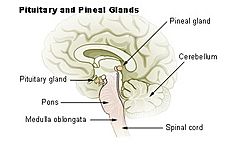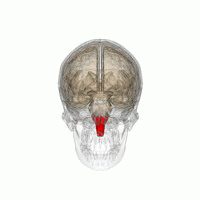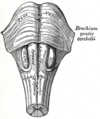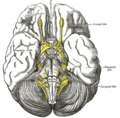Medulla oblongata facts for kids
The medulla oblongata (or medulla) is the lower half of the brainstem. It is just on top of the spinal cord. It connects the higher parts of the brain to the spinal cord (see the picture at the right of this page).
The cardiac, respiratory, and vasomotor control centers are in the medulla. This means that the medulla controls heart rate, blood pressure, breathing, and the size of the body's blood vessels. If the medulla did not work, the person would die.
Contents
Functions
The medulla does many important things. It relays nerve signals between the brain and spinal cord. Signals from the brain tell the rest of the body what to do. Signals from the spinal cord tell the brain what is going on in the body. Without the medulla, none of these signals would get through.
The medulla also controls autonomic functions (things the body does automatically, without a person having to think about them).
The breathing control center
The medulla controls breathing. Groups of neurons in the medulla tell the body when to breathe in, when to breathe faster, and when to breathe slower.
The medulla measures how much carbon dioxide is in a person's blood. When the body makes energy, carbon dioxide gets left over. The body has to get rid of extra carbon dioxide, because it is poisonous. The only way the body can get rid of carbon dioxide is by breathing it out.
If there is too much carbon dioxide in the blood, the medulla sends signals to the breathing muscles and tells them to work harder. This makes the person breathe faster, so they can breathe out the extra carbon dioxide. Once the amount of carbon dioxide in the blood is normal again, the medulla tells the body to breathe slower again.
The cardiac control center
The medulla helps control the sympathetic nervous system and the parasympathetic nervous system. The main part of the nerves that control these two systems are in the medulla. These nerves get signals from other parts of the brain and the body. These signals help tell the sympathetic and parasympathetic nervous systems what to do.
Together, these two systems control many important things, like how fast the heart beats and how hard it squeezes. In the cardiac center, there are special nerves that will make the heart beat harder and faster, called excitatory nerves. There are also inhibitory nerves, which will make the heart beat slower and not as hard. If a person's blood pressure gets too low, the cardiac center will send a message to the excitatory nerves, telling them to make the heart beat faster and harder. This raises the blood pressure. If the blood pressure gets too high, the cardiac center sends a message to the inhibitory nerves, which slow the heart down and make it not beat so hard. This lowers the blood pressure. In a healthy person, the cardiac center balances out the signals it sends to these sets of nerves, to keep the blood pressure normal.
The vasomotor control center
The vasomotor center controls the size of the body's blood vessels. When a person is stressed or in danger, the vasomotor center makes the blood vessels get smaller. This is part of the body's "fight or flight" reaction. It causes more blood to go to the body's most important organs, like the brain, heart, and lungs. This can help a person survive if they are in danger. It also makes the blood pressure go up.
At other times, the vasomotor center makes the blood vessels get wider. This makes the blood pressure go down, and makes it easier for blood to get to some parts of the body.
Reflex control centers
The medulla also controls some important reflexes, like vomiting, coughing, sneezing, and swallowing.
Other functions
Sets of neurons in the medulla help control other important things, like movement, digestion, and sleep.
Injuries to the medulla
Because the medulla controls so many important things, injuries to the medulla can cause some serious problems.
For example, an injury to the middle of the medulla can cause these symptoms:
- Paralysis on one side of the body
- Paralysis of part of the tongue
- The person may lose their sense of touch (not be able to feel anything)
- The person may lose their sense of position (not know where their body parts are)
An injury to one side of the medulla can cause these symptoms:
- Trouble swallowing
- Dizziness
- Vomiting
- The person may lose their ability to feel pain or temperature
- The person may lose their gag reflex
If a person's medulla is completely destroyed (for example, from a very bad injury, or because it did not get enough oxygen to survive), that person will die.
Images for kids
-
Medulla-animated as it protrudes from the foramen magnum of the skull-base, after which it gives rise to the spinal cord.
-
Micrograph of the posterior portion of the open part of the medulla oblongata, showing the fourth ventricle (top of image) and the nuclei of CN XII (medial) and CN X (lateral). H&E-LFB stain.
See also
 In Spanish: Bulbo raquídeo para niños
In Spanish: Bulbo raquídeo para niños








